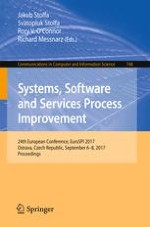2017 | Book
Systems, Software and Services Process Improvement
24th European Conference, EuroSPI 2017, Ostrava, Czech Republic, September 6–8, 2017, Proceedings
Editors: Jakub Stolfa, Svatopluk Stolfa, Prof. Dr. Rory V. O'Connor, Dr. Richard Messnarz
Publisher: Springer International Publishing
Book Series : Communications in Computer and Information Science
